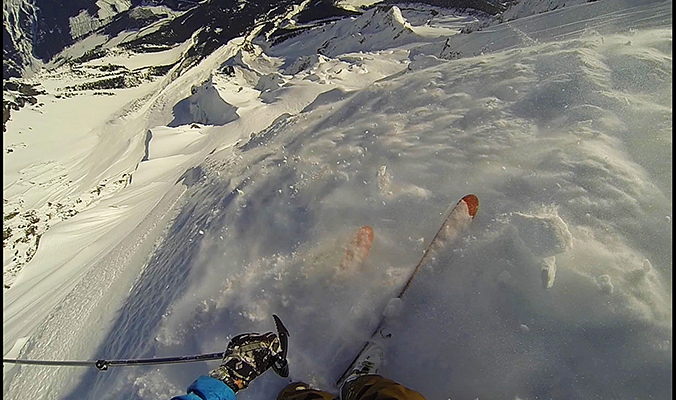Don’t worry; New Jersey’s governor hasn’t taken up photography. This Chris Christie, a resident of Squamish, B.C., has a penchant for stouts and big ski lines, and he doesn’t take being a photographer lightly. In his free time, Christie bikes in order to be fit enough to catch the perfect shot when the time comes. “Ass shots aren’t my favorite, and that’s what happens if you’re not fit,” he says. For Christie, it all started with a love of skiing, and having worked with Backcountry, TGR and Matchstick Productions, he’s now moved far beyond ass shots.
We caught up with Christie to talk 7,000-foot lines, alpine starts and bear attacks.

Website: christie-images.com
Sponsor: billygoattech.com
Home Mountain: Whistler-Blackcomb, B.C.
Gear He Can’t Live Without: “First my morning coffee. But then my Canon Mark III.”
Superpower: Flying
[Photo] Adam Clark
Chris Christie: It started back in the day, ski touring and mountaineering. I felt pretty fortunate to be in some of the locations I was in, and I wanted to share those experiences with other people. Skiing was one of my first loves and being on high mountains in the winter is remarkable. Not a lot of people get to experience that. I just kind of picked up a little point-and-shoot to start. Eventually I started stepping up my gear and making it happen.
BCM: Where does your inspiration come from?
CC: My backyard is an incredible playground. I’m intrigued by skiing as close to the ocean as I can, and, even though the access is incredibly difficult due to the rainforest typography [approximately 40% of Squamish’s Pemberton area is considered temperate rainforest], when you get up high looking down on the fjord is incredible. Norway gets all the glory, but we’ve got it here as well. It just takes a hell of a lot more work.
BCM: What goes into making a great shot?
CC: A lot of it is location, where you are, the people you’re with and the moment. I see the quality of my work reflects how much I’m out there. The more I’m out there, the better stuff I seem to get because I get more opportunities to experience that perfect moment.
BCM: What are some of the high points of your career?
CC: We skied one of the bigger lines in our local area last year, and it was something I’d been waiting to do for probably five years. It’s called Mt. Plinth, and it’s about a 7,000-foot line. It’s a very complicated descent. I had basically written it off my list because I figured it was not in my capabilities. I finally built up the confidence, and we climbed the line and skied it successfully.
I still think to this day that was the pinnacle of my skiing and photography. I was out of my skull pulling the camera out in some of my positions, but in the end I look back on that, and I still crack a smile thinking that we did it in good form. There have only been about 15 people who’ve skied it. Often the line doesn’t even come in.
BCM: What’s your biggest weakness?CC: Alpine starts—no brainer. Other than that, maybe my patience. It’s been tested over the years. I’ve sat in a lot of snow holes waiting for the light, freezing my ass off. I do have patience when it comes to safety concerns for sure, but waiting for the moment can be difficult when you would like to be out skiing.
BCM: What’s the funniest thing that has happened to you lately?
CC: A buddy who knew we were doing a backcountry circuit rented a bear suit and ran five hours ahead of us to hide in the forest. There was a common place where people had lunch and he launched himself out of the forest at us. Luckily we don’t carry guns in Canada.
BCM: What’s the sketchiest experience you have gotten into?
CC: I was involved in an incident last winter. We climbed a substantial line, and walking on the ridge we suspected a slight change in aspect. There was buried surface hoar on it, and a little pocket pulled off and carried myself and a friend over 800 feet down the main line. It was huge. Luckily it was a clean line and the debris spanned out enough so we weren’t completely buried, but it was a big one. I had a torn MCL and my friend had a minor concussion, but we got away lucky. We missed all the rocks on the way down. I don’t know how, but we did. When I looked back at the line there were two 50-foot cliffs we went off of.
BCM: Any words for an aspiring photography?
CC: Find the moment. Shoot in the morning and shoot in the late afternoon. Those are easy key things to think about. If you are submitting to magazines, just submit your best stuff. You are more likely to catch someone’s eye. Photo editors have a lot of content flying through their hands, and you’ve got one chance to catch their eye, and you better do it quick.












Related posts:
Snow Shooter: Cedric Bernardini
Snow Shooter: Photographer Abby Cooper
Snow Shooter: Jay Beyer
Snow Shooter: Ian Coble